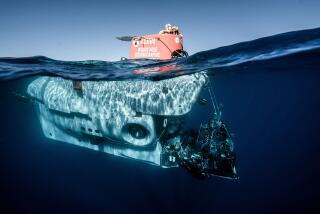Scripps Ship to Get High-Tech Sonar System
- Share via
A Scripps Institution of Oceanography research ship will gain a state-of-the-art sonar system that can “see” under 14 miles of water, thanks to a grant from the W. M. Keck Foundation.
The $1.15-million grant announced Thursday will pay most of the cost of a system that can bounce 121 sonar beams off the sea floor to make maps of the contours there. This is similar to the way a doctor can use sound waves, or ultrasound, to create images of organs in the human body.
The Sea Beam 2000 system not only can make detailed topographic maps of the sea floor, but also produces data that can be used to deduce the types of rocks there and how they were formed. Its range extends to 14 miles below the surface.
“In terms of sensing the type of bottom, which is the kind of research I’ve been involved in, this is quite an exciting system,” said Christian de Moustier, an underwater acoustics specialist at Scripps.
“It is a tool which will make life a lot easier compared to the previous one. I think it will not only open up new possibilities but also bring on new challenges,” he said.
Previous Sea Beam systems, in wide use on research and Navy ships, have yielded detailed maps of near-shore locations and a few volcanically active areas of the ocean floor. But the newer system will make it faster and easier to map the scientifically interesting parts of the floor, underwater volcanic ridges and the spreading sections of the sea floor.
In the Pacific Ocean, understanding the underwater sections of the volcanic “Ring of Fire,” which encircles the ocean, are central to the study of many phenomena, including earthquakes, volcanoes, the warm-water current called El Nino, and the greenhouse effect.
The foundation will fund $1.15 million and UC San Diego another $600,000 of the cost of Sea Beam 2000.
The U.S. Navy, which owns the Scripps ship Melville on which the unit will be installed, and the National Science Foundation also are being asked to contribute unspecified amounts.
The Melville is undergoing renovation in Louisiana. The new sonar system is expected to be installed after that work is done and to be available for use by researchers by early 1992.






